Topics 2008
December 2008
Dec. 17, 2008 Updated
Astronaut Furukawa selected to stay on ISS for prolonged period
|
Astronaut Satoshi Furukawa was selected as a crewmember of Expedition 28/29 to stay on the International Space Station (ISS) for a prolonged period. |
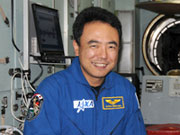
|
|---|
December 9, 2008 Updated
IBUKI open to the press at TNSC
 On December 9, the Greenhouse Gases Observing Satellite "IBUKI" was revealed to the press at the Spacecraft Test and Assembly Building #2 (STA2) at the Tanegasima Space Center (TNSC.) The IBUKI is now in its final preparation phase.
On December 9, the Greenhouse Gases Observing Satellite "IBUKI" was revealed to the press at the Spacecraft Test and Assembly Building #2 (STA2) at the Tanegasima Space Center (TNSC.) The IBUKI is now in its final preparation phase.
JAXA is accepting supportive messages to the IBUKI and its project team. We welcome your messages and images.
November 2008
November 17, 2008 Updated
Certificate, tinned herb seeds presented to IBUKI's godparents
 JAXA sent a certificate and tinned herb seeds to all 630 godparents of the Greenhouse Gases Observing Satellite "IBUKI."
JAXA sent a certificate and tinned herb seeds to all 630 godparents of the Greenhouse Gases Observing Satellite "IBUKI."
In our special site for the IBUKI, we are asking for supportive messages for the IBUKI and its project team. We are waiting for messages from those who are IBUKI's godparents as well as those who are not. Please express your expectations and support to us. The launch is only two months away. Your continuous support is very much appreciated.
November 11, 2008 Updated
Naoko Yamazaki to become second Japanese female astronaut to fly to space!
 JAXA Astronaut Naoko Yamazaki has been selected as a crew member of the Space Shuttle "Atlantis" (STS-131/19A mission).
JAXA Astronaut Naoko Yamazaki has been selected as a crew member of the Space Shuttle "Atlantis" (STS-131/19A mission).
She is scheduled to travel to the International Space Station (ISS) for about 14 days on the Atlantis in February 2010, or later.
Following this announcement, three JAXA astronauts are now scheduled to go to space. They are Astronaut Koichi Wakata, who is going to stay on the ISS for about three months by STS-119 mission, Astronaut Soichi Noguchi, who will be on the ISS for about six months after flying on the Soyuz (his backup is Astronaut Satoshi Furukawa,) and Astronaut Naoko Yamazaki on the STS 131 mission.
November 5, 2008 Updated
Launch day of "IBUKI" set! Launch Special Site open
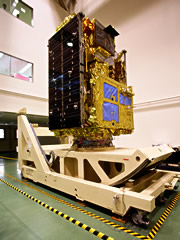 The launch day and lift-off time of the H-IIA Launch Vehicle No. 15 (H-IIA F15) was announced to be between 12:54 and 1:16 p.m. on January 21, 2009. The main payload of the H-IIA F15 is the Greenhouse Gases Observing Satellite "IBUKI" (GOSAT.)
The launch day and lift-off time of the H-IIA Launch Vehicle No. 15 (H-IIA F15) was announced to be between 12:54 and 1:16 p.m. on January 21, 2009. The main payload of the H-IIA F15 is the Greenhouse Gases Observing Satellite "IBUKI" (GOSAT.)
At the same time, the "IBUKI Launch Special Site" was also opened. We will provide updated information on the IBUKI there. Please enjoy it.
The IBUKI was open to the press on Nov. 4 at the Tsukuba Space Center. It will be transported to the Tanegashima Space Center for final launch preparations.
October 2008
October 15, 2008 Updated
'IBUKI' Chosen as Nickname of the GOSAT
 "IBUKI" was selected as the nickname of the Greenhouse Gases Observing Satellite (GOSAT), which is scheduled to be launched this Japan fiscal year, after 12,683 applications were received from the general public.
"IBUKI" was selected as the nickname of the Greenhouse Gases Observing Satellite (GOSAT), which is scheduled to be launched this Japan fiscal year, after 12,683 applications were received from the general public.
IBUKI means "breath" or "puff", and as the GOSAT is a satellite to observe carbon dioxide, which is the Earth's puff (breath), the name reflects its mission. It also is hoped that the IBUKI will provide people with "vigor" and a "bright future."
The IBUKI is going to be transported to the Tanegashima Space Center soon for launch preparations.
October 9, 2008 Updated
KAGUYA's high vision Camera captures "Full Earth-rise"
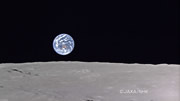 The lunar explorer "KAGUYA" acquired images of "the full earth rise and set" through its onboard high definition camera on September 30 (Japan Standard Time) following its full earth image shooting in April. Full earth images can be taken only twice a year when the Moon, Earth, Sun and KAGUYA perfectly line up.
The lunar explorer "KAGUYA" acquired images of "the full earth rise and set" through its onboard high definition camera on September 30 (Japan Standard Time) following its full earth image shooting in April. Full earth images can be taken only twice a year when the Moon, Earth, Sun and KAGUYA perfectly line up.
You can also enjoy KAGUYA observation images including movies with detailed explanations at the "KAGUYA Image Gallery" site. Please have a look and register.
September 2008
September 16, 2008 Updated
Third series of 'Space Poem Chain' launched
 The "Space Poem Chain" aims at providing the public throughout the world with a common collaborative ground to consider space, the Earth and life regardless of one's nationality, culture, generation, occupation, or role.
The "Space Poem Chain" aims at providing the public throughout the world with a common collaborative ground to consider space, the Earth and life regardless of one's nationality, culture, generation, occupation, or role.
We are happy to announce that the third series of the "Space Poem Chain" was recently launched.
For the third series, 24 poems will be compiled and edited by February 2009 with Mr. Makoto Ooka, a poet, serving as a supervisor and Mr. Kiwao Nomura, also a poet, acting as a judge. The 24 poems consist of invited contributions and those chosen from contributions by the general public worldwide.
The first poem was contributed by Mr. Makoto Ooka (poet), the second by Ms. Maiko Sugimoto (poet), and the third by Mr. Junichi Watanabe (Director of the Information Center and Outreach Department at the NINS National Astronomical Observatory). For the fourth poem, we have asked the public to contribute a three-line poem before Sept. 15, and the selection result will be announced on the 19th (Fri.) After the fourth poem is selected, we will ask for submissions for the fifth poem (a five-line poem) before Sept. 22nd (Mon.). We are looking forward to your participation.
August 2008
August 25, 2008 Updated
Science experiment starts on Kibo!
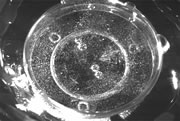 On Aug. 22, a scientific experiment began on the Japanese Experiment Module "Kibo."
On Aug. 22, a scientific experiment began on the Japanese Experiment Module "Kibo."
The fluid Physics Experiment Facility on the Fluid Experiment Rack in the Kibo Pressurized Module was remotely controlled from the Tsukuba Space Center to start the Marangoni convection research. The microgravity environment is imperative for not only generating a major scale of Marangoni convection but also for observing it for a prolonged period.
Details of the Marangoni convection are significant for further understanding the nature of fluid as well as to manufacture semiconductor materials and for the development of equipment for space use.
Various other experiments will be started as soon as functional verification of their equipment is completed on the Kibo.
(Photo:(c)JAXA / Tokyo University of Science, SUWA)
August 2, 2008 Updated
S-520-24 observation rocket successfully launched!
 The observation rocket S-520-24, which aims to uncover the mechanism for crystal growth utilizing a microgravity environment during its flight, was launched at a vertical angle of 78.4 degrees at 17:30 on August 2, 2008 (Japanese Standard Time) from the Uchinoura Space Center.
The observation rocket S-520-24, which aims to uncover the mechanism for crystal growth utilizing a microgravity environment during its flight, was launched at a vertical angle of 78.4 degrees at 17:30 on August 2, 2008 (Japanese Standard Time) from the Uchinoura Space Center.
The rocket's flight and on-board equipment all performed normally and the nose-cone was opened 55 seconds after launch. The rocket reached an altitude of 293 kilometers high in 274 seconds from the launch and all the experiments were completed. The rocket then descended to its scheduled ocean landing area southeast of Uchinoura.
Two pieces of equipment for the crystal growth experiment aboard the rocket were operated normally and acquired data.
A detailed analysis will be later performed using the acquired data.
July 2008
July 28, 2008 Updated
Astronaut Hoshide's Debriefing "Humankind is truly fabulous."
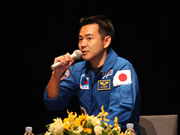 Astronaut Akihiko Hoshide, who was a crewmember on the recent Space Shuttle "Discovery" mission to assemble the Japan Experiment Module Kibo's Pressurized Module to the International Space Station, reported on his space journey at a meeting at Hibiya Kokaido Hall in Tokyo on July 26 (Sat.) While showing images taken during his mission, Astronaut Hoshide expressed his feelings while in space, "I felt that humankind was truly fabulous as we could launch such a huge object into space."
Astronaut Akihiko Hoshide, who was a crewmember on the recent Space Shuttle "Discovery" mission to assemble the Japan Experiment Module Kibo's Pressurized Module to the International Space Station, reported on his space journey at a meeting at Hibiya Kokaido Hall in Tokyo on July 26 (Sat.) While showing images taken during his mission, Astronaut Hoshide expressed his feelings while in space, "I felt that humankind was truly fabulous as we could launch such a huge object into space."
Another debriefing meeting by Astronaut Hoshide will be held in Tsukuba on July 31 (Thu) and in Nagoya on Aug. 1 (Fri).
July 10, 2008 Updated
Want to be a godparent of a satellite?
Seeking a nickname for the Greenhouse Gases Observing Satellite (GOSAT)
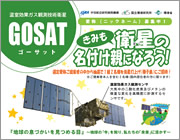 The "GOSAT" is the first satellite to observe greenhouse gas around the Earth from space in order to further promote measures to deal with global warming.
The "GOSAT" is the first satellite to observe greenhouse gas around the Earth from space in order to further promote measures to deal with global warming.
Prior to its launch to space, we are asking your help to give the GOSAT a nickname. The nickname should be either in Japanese Hiragana or Katakana characters.
Please send us some appropriate nicknames by September 10 (Wed,) 2008.
June 2008
June 15, 2008 Updated
Space Shuttle "Discovery" returns home
Great job, Astronaut Hoshide!
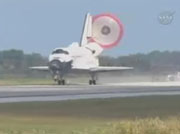 The Space Shuttle "Discovery" with Astronaut Hoshide onboard landed at NASA Kennedy Space Center at 0:15 a.m. on Sunday, June 15 (Japan Standard Time.)
The Space Shuttle "Discovery" with Astronaut Hoshide onboard landed at NASA Kennedy Space Center at 0:15 a.m. on Sunday, June 15 (Japan Standard Time.)
All its missions including the assembly of the Kibo, Japanese Experiment Module, Pressurized Module and Robotic Arm, and the moving of its Experiment Logistic Module Pressurized Section, were successfully completed.
We would like to express our sincere appreciation to all those who have been watching SPACE@NAVI-Kibo and sent us supportive messages.
The full-scale operation of the Kibo will shortly begin. Your supportive messages to Astronaut Hoshide and the Tsukuba Space Center Kibo Control Center are always welcomed.
(Photo provided by NASA)
June 12, 2008 Updated
Discovery separated from the ISS
Scheduled to come home at 0:15 a.m. on Sunday, June 15 (JST)
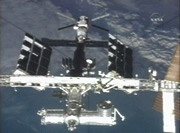 The Space Shuttle "Discovery," with Japanese Astronaut Akihiko Hoshide onboard, separated from the International Space Station (ISS) at 8:42 p.m. on Wednesday, June 11 (Japan Standard Time), after having successfully completed the assembly task of the Japanese Experiment Module "Kibo."
The Space Shuttle "Discovery," with Japanese Astronaut Akihiko Hoshide onboard, separated from the International Space Station (ISS) at 8:42 p.m. on Wednesday, June 11 (Japan Standard Time), after having successfully completed the assembly task of the Japanese Experiment Module "Kibo."
The Discovery will prepare for re-entry and return to the Earth. It is scheduled to land on Earth at NASA Kennedy Space Center (KSC) at 0:15 a.m. (JST) on Sunday (June 15).
SPACE@NAVI-Kibo SPECIAL LIVE will have a live broadcast of the return from 11:30 p.m. on Saturday, June 14, through the Internet and a mobile phone service. Please watch SPACE@NAVI-Kibo SPECIAL LIVE on the Saturday night!
We welcome your supportive messages for a safe return for Astronaut Hoshide.
(Photo provided by NASA)
June 10, 2008 Updated
Robotic Arm fully deployed!
Entry made to the Experiment Logistic Module Pressurized Section!
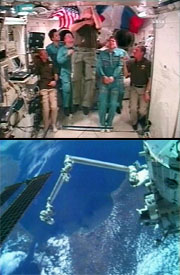 At 10:31 p.m. on Monday, June 9 (Japan Standard Time,) the tenth day of the flight, the Robotic Arm of the Japanese Experiment Module "Kibo" was fully deployed. The Kibo Experiment Logistic Module Pressurized Section, which was moved on the 7th (Sat.), was also fully prepared for use, and Astronaut Hoshide and other crew members entered it at 3:21 on the 10th (Tuesday, JST.) Early in the morning on the same day (JST), a press conference was held from the Kibo Pressurized Module for American and Japanese media on Earth.
At 10:31 p.m. on Monday, June 9 (Japan Standard Time,) the tenth day of the flight, the Robotic Arm of the Japanese Experiment Module "Kibo" was fully deployed. The Kibo Experiment Logistic Module Pressurized Section, which was moved on the 7th (Sat.), was also fully prepared for use, and Astronaut Hoshide and other crew members entered it at 3:21 on the 10th (Tuesday, JST.) Early in the morning on the same day (JST), a press conference was held from the Kibo Pressurized Module for American and Japanese media on Earth.
The next live report on the Internet and through the mobile phone service SPACE@NAVI-Kibo SPECIAL LIVE will be the return of the Space Shuttle "Discovery" from 11:30 p.m. on Saturday, June 14. Please watch the JAXA website on Saturday night!
We will continue to accept supportive messages for Astronaut Hoshide and the Kibo's ground operation team.
(Photo provided by NASA)
June 8, 2008 Updated
Astronaut Hoshide talks with Prime Minister Fukuda and Minister Tokai
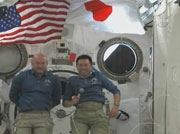 At 1:38 a.m. on Sunday, June 8 (Japan Standard Time,) the 8th day of the flight, Astronaut Hoshide performed the initial deployment of the Kibo robotic arm by controlling it through the console for the Robotic Arm in the Kibo pressurized Module. The arm was partially deployed.
At 1:38 a.m. on Sunday, June 8 (Japan Standard Time,) the 8th day of the flight, Astronaut Hoshide performed the initial deployment of the Kibo robotic arm by controlling it through the console for the Robotic Arm in the Kibo pressurized Module. The arm was partially deployed.
At 8:00 a.m. (JST,) Astronaut Hoshide and Commander Kelly spoke from the International Space Station with Japanese Prime Minister Fukuda, Minister Tokai of the Ministry of Education, Culture, Sports, Science, and Technology of Japan, and US Ambassador Thomas Schieffer, who were at the National Museum of Emerging Science and Innovation (Tokyo.) The astronauts also communicated with students from Futago Tamagawa Elementary School and Meikei Gakuen Junior High School, from which Astronaut Hoshide graduated. JAXA Astronaut Mamoru Mohri worked as a facilitator for communications.
The next live report through the Internet and mobile phone service will be between 11:30 p.m. on Saturday, June 14, and 2:30 a.m. on Sunday, June 15 (JST) on SPACE@NAVI-Kibo SPECIAL LIVE to broadcast the return of the Space Shuttle "Discovery."
Don't miss it!
(Photo provided by NASA)
June 7, 2008 Updated
Kibo Experimental Logistic Module Pressurized Section attached to Pressurized Module
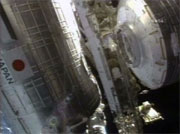 The Experimental Logistic Module Pressurized Section of the Kibo, which was delivered and temporarily attached to the Harmony (the second node) of the International Space Station (ISS) by Astronaut Doi on the J/A mission, was detached at 4:15 on Saturday, June 7 (Japan Standard Time,) the seventh day of the flight. It was then attached to its final position, to the Common Berthing Mechanism (CBM) on top of the Kibo Pressurized Module, at 6:17 (JST). Astronaut Akihiko Hoshide was in charge of controlling the CBM with Astronaut Gregory Chamitoff for both the detachment and attachment.
The Experimental Logistic Module Pressurized Section of the Kibo, which was delivered and temporarily attached to the Harmony (the second node) of the International Space Station (ISS) by Astronaut Doi on the J/A mission, was detached at 4:15 on Saturday, June 7 (Japan Standard Time,) the seventh day of the flight. It was then attached to its final position, to the Common Berthing Mechanism (CBM) on top of the Kibo Pressurized Module, at 6:17 (JST). Astronaut Akihiko Hoshide was in charge of controlling the CBM with Astronaut Gregory Chamitoff for both the detachment and attachment.
On the 10th day of the flight, the crew will open the hatch and enter the Pressurized Module again.
On Sunday (June 8, JST,) Kibo’s robotic arm will be deployed for the first time.
SPACE?NAVI-Kibo SPECIAL LIVE will broadcast a live report from 0:30 a.m. on the 8th (Sun) through the Internet and their mobile phone service. Please watch it.
(Photo provided by NASA)
June 5, 2008 Updated
Welcome to the Kibo Pressurized Module!
Astronaut Hoshide enters lab
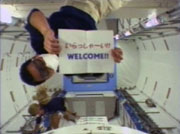 At 6:09 on Thursday, June 5 (Japan Standard Time), the fifth day of the flight, the hatch of the Kibo Pressurized Module was opened, and Astronaut Hoshide and other crew members entered it by going through a curtain that says "Kibo" in Japanese.
At 6:09 on Thursday, June 5 (Japan Standard Time), the fifth day of the flight, the hatch of the Kibo Pressurized Module was opened, and Astronaut Hoshide and other crew members entered it by going through a curtain that says "Kibo" in Japanese.
On Saturday, June 7 (JST,) the Experiment Logistic Module Pressurized Section of the Kibo, which was delivered and temporarily attached to the ISS by Astronaut Doi on the J/A mission, will be moved from the current position on the Harmony to on top of the Pressurized Module.
SPACE@NAVI-Kibo SPECIAL LIVE will broadcast a live report from 4:00 a.m. on the 7th (Sat) through the Internet and their mobile phone service. Please watch it.
(Photo provided by NASA)
June 4, 2008 Updated
Kibo Pressurized Module successfully attached to ISS!
 At 5:49 a.m. on Wednesday, June 4 (JST,) the fourth day of the flight, Astronaut Akihiko Hoshide retrieved the Kibo Pressurized Module from Discovery's cargo bay by manipulating the robotic arm (SSRMS) of the International Space Station (ISS.) Then, at 8:42 (JST,) the Kibo Pressurized Module was successfully installed on the port side of the Harmony node (the second node) of the ISS.
At 5:49 a.m. on Wednesday, June 4 (JST,) the fourth day of the flight, Astronaut Akihiko Hoshide retrieved the Kibo Pressurized Module from Discovery's cargo bay by manipulating the robotic arm (SSRMS) of the International Space Station (ISS.) Then, at 8:42 (JST,) the Kibo Pressurized Module was successfully installed on the port side of the Harmony node (the second node) of the ISS.
On Thursday, June 5 (JST,) electric power will be turned on in the Kibo Pressurized Module, and Astronaut Hoshide and other crew members will enter the Module. SPACE@NAVI-Kibo SPECIAL LIVE will broadcast a live report from 5:00 a.m. through the Internet and the mobile phone service. Please watch it.
(Photo provided by NASA)
June 3, 2008 Updated
Discovery docks with the ISS
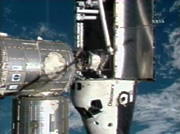 The Space Shuttle "Discovery," with the Pressurized Module and Robotic Arm of the Japan Experiment Module "Kibo" aboard, successfully docked with the International Space Station (ISS) at 3:03 a.m. on June 3 (Japan Standard Time) over the South Pacific Ocean. At 4:36 a.m. (JST), the hatch was opened and the Discovery crew on mission STS-124/J1, including Astronaut Hoshide, entered the ISS.
The Space Shuttle "Discovery," with the Pressurized Module and Robotic Arm of the Japan Experiment Module "Kibo" aboard, successfully docked with the International Space Station (ISS) at 3:03 a.m. on June 3 (Japan Standard Time) over the South Pacific Ocean. At 4:36 a.m. (JST), the hatch was opened and the Discovery crew on mission STS-124/J1, including Astronaut Hoshide, entered the ISS.
Early on Wednesday morning, June 4 (JST,) Astronaut Hoshide will manipulate the ISS's Robotic Arm (SSRMS) to attach the Kibo Pressurized Module to the ISS. This operation will be reported live from 5:30 a.m. through the Internet and a mobile phone service by SPACE@NAVI-Kibo SPECIAL LIVE.
Let's watch it together!
(Photo provided by NASA)
June 1, 2008 Updated
Have a nice trip, Astronaut Hoshide! Discovery launched with Kibo's Pressurized Module
 The Space Shuttle "Discovery," with Astronaut Hoshide onboard, was launched from the Kennedy Space Center at 6:02 a.m. on Sunday, June 1 (Japan Standard Time). This STS-124/J1 mission will deliver the Pressurized Module and Robotic Arm of the Japanese Experiment Module "Kibo."
The Space Shuttle "Discovery," with Astronaut Hoshide onboard, was launched from the Kennedy Space Center at 6:02 a.m. on Sunday, June 1 (Japan Standard Time). This STS-124/J1 mission will deliver the Pressurized Module and Robotic Arm of the Japanese Experiment Module "Kibo."
The mission includes many programs such as docking with the International Space Station (ISS), attaching the Kibo's modules to the ISS, and moving the Experiment Logistics Module - Pressurized Section, which was delivered to the ISS through 1J/A mission.
SPACE@NAVI-Kibo SPECIAL LIVE will broadcast a live report of the above events through the Internet as well as through a mobile phone service. We will also provide a replay so you never have to miss anything.
Your support messages to Astronaut Hoshide are also welcomed!
The next live report is around 4:30 a.m. on Tuesday, June 3 (JST,) to report the docking of the Discovery with the ISS. It will cover the moment of the Discovery crew entering the ISS.
(Photo provided by NASA)
May 2008
May 26, 2008 Updated
Let's wake up early and cheer on the launch of Astronaut Hoshide on Sunday, June 1!
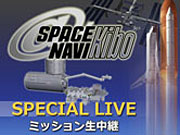 At 6:02 a.m. on Sunday, June 1 (Japan Standard Time,) the Space Shuttle “Discovery,” with Astronaut Hoshide onboard, is scheduled to be launched. The mission, the 1J (STS-124), is the second delivery mission of the Japanese Experiment Module “Kibo,” and the main module, the Pressurized Module, and the Robotic Arm are planned to be attached to the International Space Station (ISS.)
At 6:02 a.m. on Sunday, June 1 (Japan Standard Time,) the Space Shuttle “Discovery,” with Astronaut Hoshide onboard, is scheduled to be launched. The mission, the 1J (STS-124), is the second delivery mission of the Japanese Experiment Module “Kibo,” and the main module, the Pressurized Module, and the Robotic Arm are planned to be attached to the International Space Station (ISS.)
JAXA will broadcast a live Internet report with Japanese explanations of the launch of the Discovery, as well as the Kibo's installation, and the return of the Shuttle to Earth. We also plan a repeat of the report, thus if you miss the real-time event, you can still watch it.
The live report starts at 5:30 a.m. on June 1. Let's wake up early on Sunday to cheer on the launch of Astronaut Hoshide and the Kibo!
May 20, 2008 Updated
Astronaut Hoside and the Kibo Pressurized Module to travel to space on June 1!
 The launch date and time for the Space Shuttle “Discovery,” on which JAXA Astronaut Akihiko Hoshide is scheduled to be aboard, was officially announced as 6:02 a.m. on June 1, Sunday (Japan Standard Time.) The 1J (STS-124) mission is the second delivery of the Japanese Experiment Module “Kibo.” It aims to attach the Kibo’s Pressurized Module and Robotic Arms to the International Space Station.
The launch date and time for the Space Shuttle “Discovery,” on which JAXA Astronaut Akihiko Hoshide is scheduled to be aboard, was officially announced as 6:02 a.m. on June 1, Sunday (Japan Standard Time.) The 1J (STS-124) mission is the second delivery of the Japanese Experiment Module “Kibo.” It aims to attach the Kibo’s Pressurized Module and Robotic Arms to the International Space Station.
May 14, 2008 Updated
Astronaut Noguchi selected as crew member for ISS Expedition
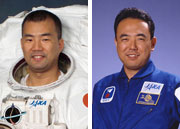 JAXA Astronaut Soichi Noguchi was selected as a key member of the 20th Expedition to the International Space Station (ISS) for a six-month stay, and Astronaut Satoshi Furukawa was chosen as his backup. Astronaut Noguchi will mainly conduct space utilization activities such as Japan's scientific experiments on the ISS, where six other crew members on the flight will join him.
JAXA Astronaut Soichi Noguchi was selected as a key member of the 20th Expedition to the International Space Station (ISS) for a six-month stay, and Astronaut Satoshi Furukawa was chosen as his backup. Astronaut Noguchi will mainly conduct space utilization activities such as Japan's scientific experiments on the ISS, where six other crew members on the flight will join him.
May 9, 2008 Updated
Kibo's Japanese Pressurized Module loaded on the Space Shuttle
Astronaut Hoshide arrived at the Kennedy Space Center for final training
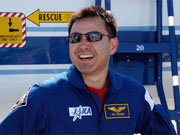 Astronaut Akihiko Hoshide, who is set to join the STS-124 mission (1J) to the International Space Station (ISS), arrived at the Kennedy Space Center on the 6th of May (U.S. Time) for the final training session before the Shuttle’s launch. In this mission, the Kibo’s Japanese Pressurized Module (JPM) and robotic arm, the Remote Manipulator System (JEMRMS) will be connected to the ISS.
Astronaut Akihiko Hoshide, who is set to join the STS-124 mission (1J) to the International Space Station (ISS), arrived at the Kennedy Space Center on the 6th of May (U.S. Time) for the final training session before the Shuttle’s launch. In this mission, the Kibo’s Japanese Pressurized Module (JPM) and robotic arm, the Remote Manipulator System (JEMRMS) will be connected to the ISS.
This final training session is called the Terminal Countdown Demonstration Test (TCDT), in which astronauts will actually board the Space Shuttle Discovery in their orange pressure suits and simulate the count down right up to the final launch.
The Space Shuttle Discovery was moved to the launch pad on May 3 (U.S. Time), and the JPM and JEMRMS were loaded in the payload bay (hold) on May 5 (U.S. Time) and are ready for the countdown.
April 2008
April 11, 2008 Updated
KAGUYA's high vision Camera captures "Full Earth-rise!"
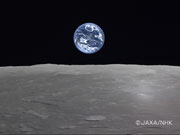 The lunar explorer KAGUYA initially captured the right-side waned "Earth-rise" in November 2007 with its high-vision camera, but this time, it succeeded in capturing the "Full Earth-rise" without any wane. This is the first time that a high-vision image of the "Full Earth-rise" has been captured from space, 380,000 kilometers away from Earth.
The lunar explorer KAGUYA initially captured the right-side waned "Earth-rise" in November 2007 with its high-vision camera, but this time, it succeeded in capturing the "Full Earth-rise" without any wane. This is the first time that a high-vision image of the "Full Earth-rise" has been captured from space, 380,000 kilometers away from Earth.
To capture the Full Earth, the Moon, Earth, Sun and KAGUYA’s circulating orbits have to fall into a straight line. This peculiar positioning occurs only 2 times a year.
April 9, 2008 Updated
KAGUYA creates topographical map of the Moon 10 times more accurate than before
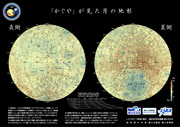 Using the Laser Altimeter (LALT) aboard the Lunar Explorer KAGUYA, JAXA acquired data covering the entire Moon’s surface and produced a topographical map of the Moon in cooperation with the National astronomical Observatory of Japan and the Geographical Survey Institute.
Using the Laser Altimeter (LALT) aboard the Lunar Explorer KAGUYA, JAXA acquired data covering the entire Moon’s surface and produced a topographical map of the Moon in cooperation with the National astronomical Observatory of Japan and the Geographical Survey Institute.
The LALT aboard the KAGUYA acquired the altitude data on the entire Moon, including the polar regions (above longitude 75 degrees), where other Lunar explorations had never investigated before. The number of measurement points is over 6 million (as of end of March, 2008), which exceeds 1 digit more than that of the former model Unified Lunar Control Network 2005 (ULCN 2005). From now on, the density of measurement points will increase through continued observations and a topographical map with even greater accuracy is anticipated.
March 2008
March 31, 2008 Updated
Let's go to space and explore the future!
Accepting applications for Japanese astronaut candidates from April 1
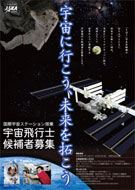 JAXA is recruiting new Japanese astronaut candidates for the first time in 10 years. The candidates are expected to stay at the International Space Station (ISS) for a prolonged period of time to engage in the operation and maintenance of the Japanese Experiment Module “Kibo” and the ISS itself, as well as to be in charge of carrying out space utilization missions in various areas. Applications should be submitted between April 1 and June 20. We are looking for enthusiastic applicants who are willing to explore space frontiers and who will contribute to the welfare of mankind.
JAXA is recruiting new Japanese astronaut candidates for the first time in 10 years. The candidates are expected to stay at the International Space Station (ISS) for a prolonged period of time to engage in the operation and maintenance of the Japanese Experiment Module “Kibo” and the ISS itself, as well as to be in charge of carrying out space utilization missions in various areas. Applications should be submitted between April 1 and June 20. We are looking for enthusiastic applicants who are willing to explore space frontiers and who will contribute to the welfare of mankind.
March 27, 2008 Updated
Space Shuttle Endeavour Lands Safely
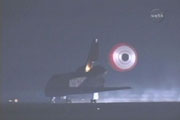 The National Aeronautics and Space Administration (NASA) advised that the Space Shuttle Endeavour with Astronaut Doi onboard successfully landed at 9:39 a.m. on March 27, Japan Standard Time (JST), at Kennedy Space Center in Florida, U.S.A., to complete its mission in 15 days, 18 hours and 11 minutes.
The National Aeronautics and Space Administration (NASA) advised that the Space Shuttle Endeavour with Astronaut Doi onboard successfully landed at 9:39 a.m. on March 27, Japan Standard Time (JST), at Kennedy Space Center in Florida, U.S.A., to complete its mission in 15 days, 18 hours and 11 minutes.
March 25, 2008 Updated
Space Shuttle Endeavour separated from the ISS
Scheduled to return at 9:39 on March 27, 2008
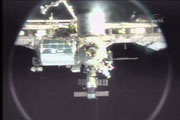 The Space Shuttle Endeavour, with Japanese Astronaut Takao Doi aboard, completed assembly of the Japanese Experiment Module "Kibo" and successfully performed five Extra Vehicular Activities, before separating from the International Space Station (ISS) at 9:25 (Japanese Standard Time, JST) on March 25, 2008.
The Space Shuttle Endeavour, with Japanese Astronaut Takao Doi aboard, completed assembly of the Japanese Experiment Module "Kibo" and successfully performed five Extra Vehicular Activities, before separating from the International Space Station (ISS) at 9:25 (Japanese Standard Time, JST) on March 25, 2008.
The Endeavour will now make preparations for re-entry and landing and is scheduled to return to earth at 9:39 (JST) on March 27, 2008.
March 20, 2008 Updated
"Hello from the Kibo"
Astronaut Doi communicates with Prime Minister Fukuda
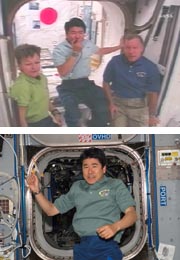 On the morning of March 20 (Japan Standard Time), Astronauts Takao Doi, Dominic Gorie and Peggy Whitson communicated with Prime Minister Yasuo Fukuda at his official residence. They also spoke with Kisaburo Tokai, Minister of Education, Culture, Sports, Science and Technology, and students from Astronaut Doi's old Higashi Junior High School in Kofu-shi, Yamanashi Prefecture. Astronaut Mukai acted as a facilitator at the Prime Minister's official residence.
On the morning of March 20 (Japan Standard Time), Astronauts Takao Doi, Dominic Gorie and Peggy Whitson communicated with Prime Minister Yasuo Fukuda at his official residence. They also spoke with Kisaburo Tokai, Minister of Education, Culture, Sports, Science and Technology, and students from Astronaut Doi's old Higashi Junior High School in Kofu-shi, Yamanashi Prefecture. Astronaut Mukai acted as a facilitator at the Prime Minister's official residence.
During his free time after work on the 8th day of the flight, Astronaut Doi threw a boomerang inside the International Space Station. To his surprise, it came back to him even in the zero-gravity environment.
March 15, 2008 Updated
"Kibo's" door finally opens up! Astronaut Doi enters module.
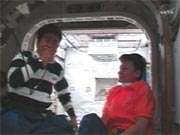 On Saturday, March 15, the fifth day of the mission, the hatch to the Experiment Logistics Module - Pressurized Section (ELM-PS) of the Japanese Experiment Module “Kibo” was opened and Space Shuttle crewmembers, including Astronaut Takao Doi, entered the module at 10:30 a.m. (Japanese Standard Time).
On Saturday, March 15, the fifth day of the mission, the hatch to the Experiment Logistics Module - Pressurized Section (ELM-PS) of the Japanese Experiment Module “Kibo” was opened and Space Shuttle crewmembers, including Astronaut Takao Doi, entered the module at 10:30 a.m. (Japanese Standard Time).
As the crewmembers entered the lab, we received a message from Astronaut Doi at the control room in Tsukuba, saying, “People in Japan, this is from the Kibo. It’s great pleasure for me to work in the Kibo. This is the opening of a new and magnificent space era for Japan. Congratulations everyone!”
March 11, 2008 Updated
Space Shuttle Endeavour successfully launched! Astronaut Doi's second trip to space
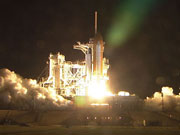 The Space Shuttle Endeavour, Mission STS-123 (1J/A), which is carrying the Experiment Logistics Module - Pressurized Section (ELM-PS) of the Japanese Experiment Module "Kibo," and has Japanese Astronaut Takao Doi aboard, was successfully launched from NASA’s Kennedy Space Center at 15:28 p.m. (Japan Standard Time, JST) on Tuesday, March 11th.
The Space Shuttle Endeavour, Mission STS-123 (1J/A), which is carrying the Experiment Logistics Module - Pressurized Section (ELM-PS) of the Japanese Experiment Module "Kibo," and has Japanese Astronaut Takao Doi aboard, was successfully launched from NASA’s Kennedy Space Center at 15:28 p.m. (Japan Standard Time, JST) on Tuesday, March 11th.
The Endeavour is scheduled to dock with the International Space Station (ISS) and attach Kibo’s experiment module to the ISS. The space shuttle is expected to return to Earth around 9:33 a.m. (JST) on Thursday, March 27.
There will be a special live Internet broadcast through “SPACE@NAVI-Kibo SPECIAL LIVE” of various scenes, from the Space Shuttle Endeavour docking with the ISS, to the connection of the Kibo, to the return of Astronaut Doi to Earth.
March 10, 2008 Updated
Your support is appreciated!
Watch the live launch on the 11th and cheer on Astronaut Doi
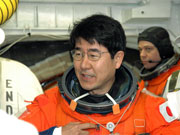 The Space Shuttle "Endeavour," which JAXA Astronaut Takao Doi will be aboard, is scheduled for launch at 3:28 p.m. (Japan Standard Time) on the 11th (Tue.)
The Space Shuttle "Endeavour," which JAXA Astronaut Takao Doi will be aboard, is scheduled for launch at 3:28 p.m. (Japan Standard Time) on the 11th (Tue.)
The 1J/A (STS-123) is the first "Kibo" delivery mission to the International Space Station (ISS,) and the Experiment Logistics Module Pressurized Section of the Japanese Experiment Module "Kibo" will be attached to the ISS.
JAXA will broadcast a live report in Japanese through the Internet from 11:30 a.m. on the 11th (Tue.) From 3:00 p.m., the live launch report will be broadcast at JAXA field centers all over Japan, and at JAXA i. Please come and join us!
We are asking for your continued messages of support for Astronaut Doi.
*The date and time of the live report is subject to change due to launch preparations and/or weather conditions.
March 1, 2008 Updated
"KIZUNA"Completion of the Critical Operation Phase
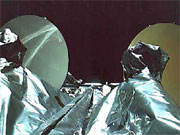 JAXA completed the critical operation phase of the KIZUNA (WINDS,) whose multi-beam antennas had been successfully deployed, at 8:35 p.m. on March 1 (JST.)
JAXA completed the critical operation phase of the KIZUNA (WINDS,) whose multi-beam antennas had been successfully deployed, at 8:35 p.m. on March 1 (JST.)
We will further maneuver the orbit from the drift orbit to the geostationary orbit (at about 143 degrees east longitude) sometime around March 14. We will also carry out the initial functional verification of the onboard equipment for about four months.
February 2008
February 23, 2008 Updated
Launch Result of the KIZUNA by the H-IIA Launch Vehicle No. 14
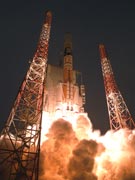 Mitsubishi Heavy Industries, Ltd. and the Japan Aerospace Exploration Agency (JAXA) launched the Wideband InterNetworking engineering test and Demonstration Satellite "KIZUNA" (WINDS) by the H-IIA Launch Vehicle No. 14 (H-IIA F14) at 5:55 p.m. on February 23, 2008 (Japan Standard Time, JST) from the Tanegashima Space Center.
Mitsubishi Heavy Industries, Ltd. and the Japan Aerospace Exploration Agency (JAXA) launched the Wideband InterNetworking engineering test and Demonstration Satellite "KIZUNA" (WINDS) by the H-IIA Launch Vehicle No. 14 (H-IIA F14) at 5:55 p.m. on February 23, 2008 (Japan Standard Time, JST) from the Tanegashima Space Center.
The launch vehicle flew smoothly, and, at about 28 minutes and 3 seconds after liftoff, the separation of the KIZUNA was confirmed.
February 20, 2008 Updated
New Launch Day of the KIZUNA by H-IIA F14
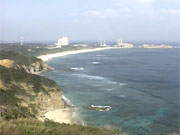 Today, Mitsubishi Heavy Industries, Ltd. and the JAXA confirmed we could carry out the launch on February 23, 2008 (JST) based on the progress of the investigation and replacement work that was concluded yesterday. The launch time has been set between 4:20 and 5:55 p.m. (JST.)
Today, Mitsubishi Heavy Industries, Ltd. and the JAXA confirmed we could carry out the launch on February 23, 2008 (JST) based on the progress of the investigation and replacement work that was concluded yesterday. The launch time has been set between 4:20 and 5:55 p.m. (JST.)
JAXA will start its broadcast of the KIZUNA launch from the Tanegashima Space Center. You can watch the live report through the Internet, at JAXA facilities, JAXA i, science museums and public viewing areas. It will also be broadcast by some cable TV stations and through the (FOMA) mobile phone service.
February 13, 2008 Updated
Launch Postponement of the KIZUNA (WINDS)
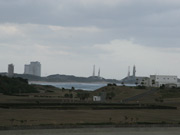 Mitsubishi Heavy Industries, Ltd. and the Japan Aerospace Exploration Agency would like to announce that we have decided to postpone the launch of the Wideband InterNetworking engineering test and Demonstration Satellite "KIZUNA" (WINDS) by H-IIA Launch Vehicle No. 14 (H-IIA F14) as an incompatibility was found with the gas jet thruster for second stage attitude control when propellant loading operations for the thruster were being carried out last night. Since it is expected to take time to deal with the problem, we decided to postpone the launch.
Mitsubishi Heavy Industries, Ltd. and the Japan Aerospace Exploration Agency would like to announce that we have decided to postpone the launch of the Wideband InterNetworking engineering test and Demonstration Satellite "KIZUNA" (WINDS) by H-IIA Launch Vehicle No. 14 (H-IIA F14) as an incompatibility was found with the gas jet thruster for second stage attitude control when propellant loading operations for the thruster were being carried out last night. Since it is expected to take time to deal with the problem, we decided to postpone the launch.
The launch was originally scheduled for February 15, 2008 (Japan Standard Time, JST.)
The new launch date will be announced as soon as it is determined.
February 6, 2008 Updated
"KIZUNA" finally moved to the Vehicle Assembly Building
JAXA broadcast starts at 4:00 p.m. on the 15th (JST)
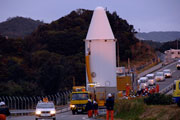 On Feb. 5, the super high-speed Internet satellite “KIZUNA” (WINDS) was transferred to the Vehicle Assembly Building (VAB.) The satellite will be loaded onto the H-IIA to be ready for the launch.
On Feb. 5, the super high-speed Internet satellite “KIZUNA” (WINDS) was transferred to the Vehicle Assembly Building (VAB.) The satellite will be loaded onto the H-IIA to be ready for the launch.
On the 15th at 4:00 p.m. (Japan Standard Time), JAXA will start its broadcast of the KIZUNA launch from the Tanegashima Space Center. You can watch the live report through the Internet, at JAXA facilities, JAXA i, science museums and public viewing areas. It will also be broadcast by some cable TV stations and through the (FOMA) mobile phone service.
January 2008
January 4, 2008 Updated
"Expect more from JAXA in 2008"
New Year's Greetings from President Tachikawa
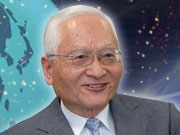 In 2008, JAXA hopes to achieve more with new ideas.
In 2008, JAXA hopes to achieve more with new ideas.
For us at JAXA, this New Year can be called a "dawn year" for the Japanese to make further advancements in space as the Japanese experiment module will be attached to the International Space Station and three Japanese astronauts are scheduled to fly to space. In addition, we would like to contribute to a safe and peaceful society through the utilization of space such as the use of our satellites for environmental problems and disaster preparations.
Furthermore, we would like to work on new Moon and asteroid exploration missions for the future. JAXA has high hopes for its activities in 2008.